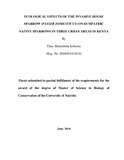| dc.description.abstract | House sparrow is one of the world’s most successful avian invasive species. It has colonized many ur
ban
environments in central Europe, Central Asia and Africa.
It was accidentally
introduced to Kenya in Momba
sa
in 1950
and
h
as since spread inland to major cities and minor towns
. The factors contributing to the rapid spread
of the species and quick establishment in inland urban areas are not well understood. The purpose of
this study
was
to
investigate the ecol
ogical effects of the invasive house sparrow on the native sympatric sparrows in three
cities (Mombasa, Nairobi and Nakuru) in Kenya. The specific objectives of this study were
t
o determine the
relative abundance of the House Sparrow and the native sympatr
ic sparrows in Mombasa,
Nairobi and Nakuru
,
determine
the
morphological and behavioural traits that facilitates
its
dispersal and colonization
in the three u
rban environments, i
dentify the competitive
interactions between the invasive hou
se sparrow and nat
ive sympatric
sparrows
, and
t
o
establ
ish how
different
human settlement structures and
social economic activities influence the spread and
settlement of the House Sparrow
.
Three transects (1800 meters each) were laid in different habitats inhabited by
h
uman
s
. Points counts were carried out on each transect to investigate sparrow abundance, avian species
diversity and richness.
Feeding experiments were used to test
for
competition and food preferences between
house sparrow and native species. Mist nets we
re used to capture sparrows to test morphometric differences in
body sizes among sparrow populations in the cities of study. A sample of 20 adult house sparrows wa
s
measured for wing, tarsus, weight and head at each study site. Nesting experiments were c
arried out using nest
boxes to investigate competition for nesting sites and nest selection between the invasive sparrow a
nd the native
sympatric species.
The results indicated that house sparrows coexisted with native sparrows as well as other
bird specie
s in all the three urban areas studied. A total of
2990 individual birds, belonging to
72
species of
28
families were recorded
in the three sites during the
point
counts
established along the baseline transects
.
There
were 890
House Sparrow
s, representing
30% of the total number of
birds observed.
There was a significance
difference in species abundance among the study sites
(
P= 0.052). The differences in feeding
guilds among the
three sites were
not significant (P=0.064).
Mombasa had the highest number o
f house sparrows with the least
species dive
rsity and richness (21 species), while
Nakuru had the least
number of
house sparrow
s
(n= 96) but
with the
highest bird
species diversity and richness (n= 48
species
).
The
native grey
-
headed sparrow
was
the
most
c
ommon associate
of house sparrow in nesting and feeding areas
.
The wing length of house sparrows in
the three study sites differed significantly
(F
0.05, 2, 87,
3.477, = 0.035), with birds in
Mombasa
having
s
horter
wings
compared to
those in
Nairobi and Nak
uru. This study has established
that house
sparrows
competed with
native sympatric
sparrows for grain food and nest sites, but there was no sufficient evidence that the invasive
sparrows had displaced the native sparrows or significantly changed the commun
ity structure of urban avifauna | en_US |

